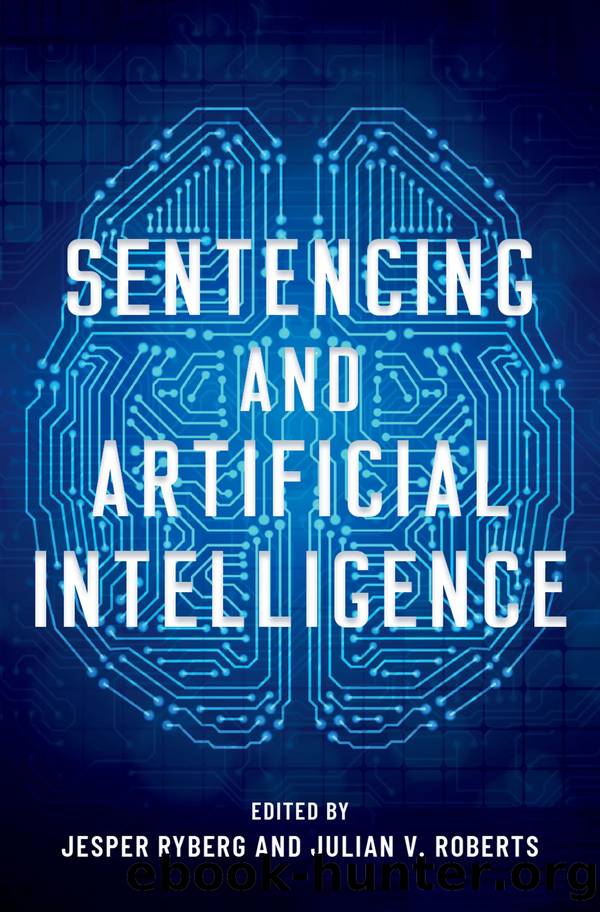Sentencing and Artificial Intelligence by Ryberg Jesper;Roberts Julian V.;

Author:Ryberg, Jesper;Roberts, Julian V.;
Language: eng
Format: epub
Publisher: Oxford University Press, Incorporated
Published: 2021-04-15T00:00:00+00:00
7.4 Conclusion
The likelihood that an offender will reoffend is an important consideration regarding three sentencing objectives: specific deterrence, rehabilitation, and community protection. Despite the seminal role of this factor, the courts and lawmakers have not set out in detail the process by which this should be determined. Thus, courts are inaccurate in making these decisions.
It is thus, not surprising that in at least some jurisdictions algorithmic decision-making is being used to determine the risk of recidivism. This technology is still at an early stage and its use is controversial, especially because some commentators have argued that programs discriminate against certain offenders. Despite this, artificial intelligence promises to ameliorate many of the limitations in human decision-making in sentencing.
The factors that culminate in people committing crime are not random. They are numerous and complex but identifiable in the same way as life expectancy. No insurance company would use human judgment to determine life insurance premiums and no court should only use judges to determine recidivism risk.
The real question is not whether artificial intelligence should or will replace judges, but rather what the design features of an optimal sentencing system that involves both humans and machines. The key to securing greater receptivity and efficacy of artificial intelligence in all areas of the criminal justice is ensuring greater transparency regarding the design of the algorithms and explaining their operation to users and the public. But even then, the aversion that we all have to inexplicable machine decisions will mean a long and difficult journey for those seeking the adoption of automated decision-making in sentencing.
References
Abrams, D. S., M. Bertrand, and S. Mullainathan. 2012. âDo Judges Vary in Their Treatment of Race?â The Journal of Legal Studies 41: 347â383.
Adadi, A., and M. Berrada. 2018. âPeeking Inside the Black-Box: A Survey on Explainable Artificial Intelligence (XAI).â IEEE Access 6: 52138â52160.
Austin, J., L.-B. Eisen, J. Cullen, J. Frank, I. Chattiar, and C. W. Brooks. 2017. âHow Many Americans Are Unnecessarily Incarcerated?â Federal Sentencing Reporter 29: 140â174.
Bagaric, M., D. Hunter, and N. Stobbs. 2019. âErasing the Bias against Using Artificial Intelligence to Predict Future Criminality: Algorithms Are Color Blind and Never Tire.â University of Cincinnati Law Review 88: 1037â1081.
Bagaric, M., D. Hunter, and N. Stobbs. 2020. âFramework for the Efficient and Ethical Yse of Artificial Intelligence in the Criminal Justice System.â Florida State University Law Review: 47: 749â800.
Bakker, L., J. OâMalley, and D. Riley. 1999â. Risk of Reconviction: Statistical Models Which Predict Four Types of Re-offending,â viewed September 6, 2020, https://www.corrections.govt.nz/__data/assets/pdf_file/0020/10667/roc.pdf
Berk, R., and J. Hyatt. 2015. âMachine Learning Forecasts of Risk to Inform Sentencing Decisions.â Federal Sentencing Reporter 27: 222â228.
Bolingford, I., M. Bagaric, M. Bull, D. Hunter, and N. Stobbs. 2020. âIs Australia Ready for AI on the Bench?â Journal of Judicial Administration 30: 3â18.
Corbett-Davies, S., S. Goel, and S. Gonzales-Bailon. 2017. âEven Imperfect Algorithms Can Improve the Criminal Justice System.â New York Times, viewed September 6, 2020, https://www.nytimes.com/2017/12/20/upshot/algorithms-bail-criminal-justice-system.html.
Department of Justice. 2020. âDepartment of Justice Announces Enhancements to the Risk Assessment System and Updates on First Step Act Implementation,â viewed September 5, 2020, https://www.
Download
This site does not store any files on its server. We only index and link to content provided by other sites. Please contact the content providers to delete copyright contents if any and email us, we'll remove relevant links or contents immediately.
Constitutional Law by Erwin Chemerinsky;(156)
Sentencing and Artificial Intelligence by Ryberg Jesper;Roberts Julian V.;(150)
European Witch Trials (RLE Witchcraft) by Richard Kieckhefer(148)
Solve Your Money Troubles by Amy Loftsgordon;Cara O'Neill;(146)
Roman Law and Economics by unknow(132)
Dictionary of American Criminal Justice by Dean J. Champion(129)
Juvenile Risk and Needs Assessment by Christopher J. Sullivan Kristina K. Childs(127)
Policing the Police : Knowledge Management in Law Enforcement by Petter Gottschalk(126)
Incarceration without Conviction by Mikaela Rabinowitz(119)
The Supreme Court's Role in Mass Incarceration by William T. Pizzi(118)
The Eternal Criminal Record by James B. Jacobs(117)
A Constitution for the Living by Beau Breslin(117)
The Legal Guide for Museum Professionals by Courtney Julia;(116)
Lawyers, Lead On by Williford Rebecca S.;Basas Carrie A.;Enyart Stephanie L.;(112)
Law for Student Police Officers by Merritt Jonathan;(112)
Crime and the Life Course by Michael L. Benson(109)
Zionism, Palestinian Nationalism and the Law: 1939-1948 by Steven E Zipperstein(109)
Revitalizing Victimization Theory by Travis C. Pratt Jillian J. Turanovic(105)
Juvenile Homicides : A Social Disorganization Perspective by Minna K. Laurikkala(103)
